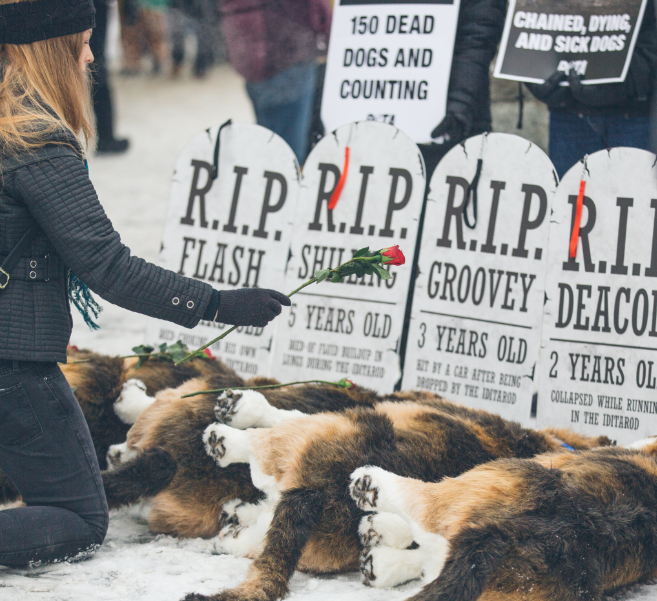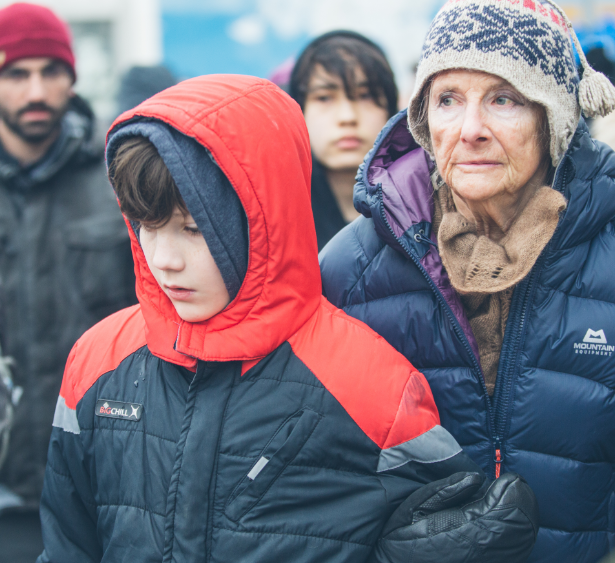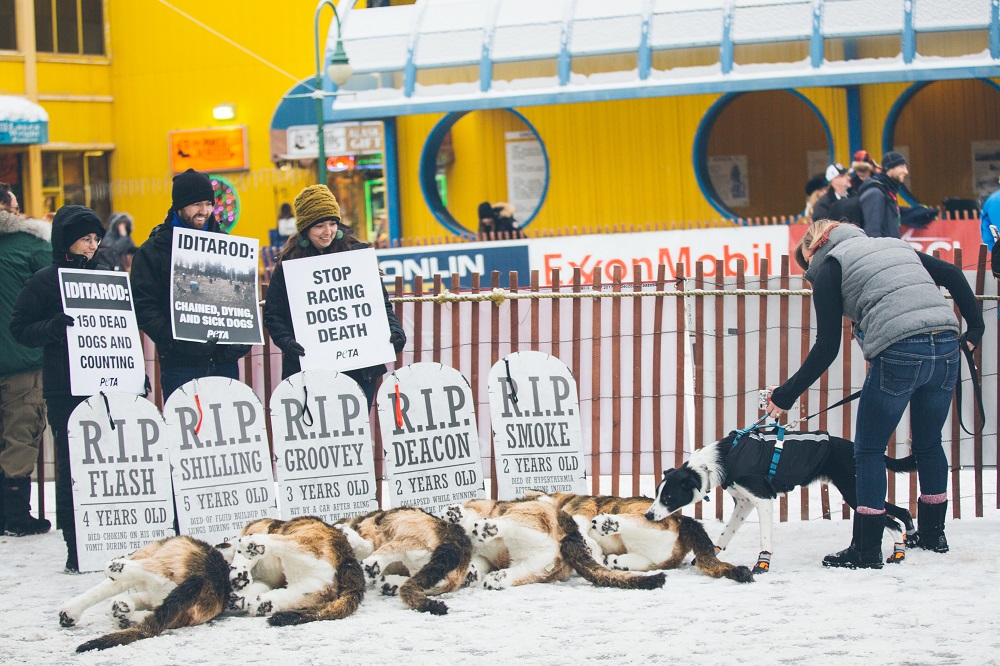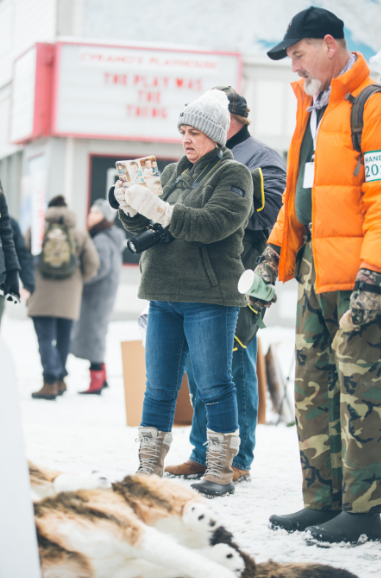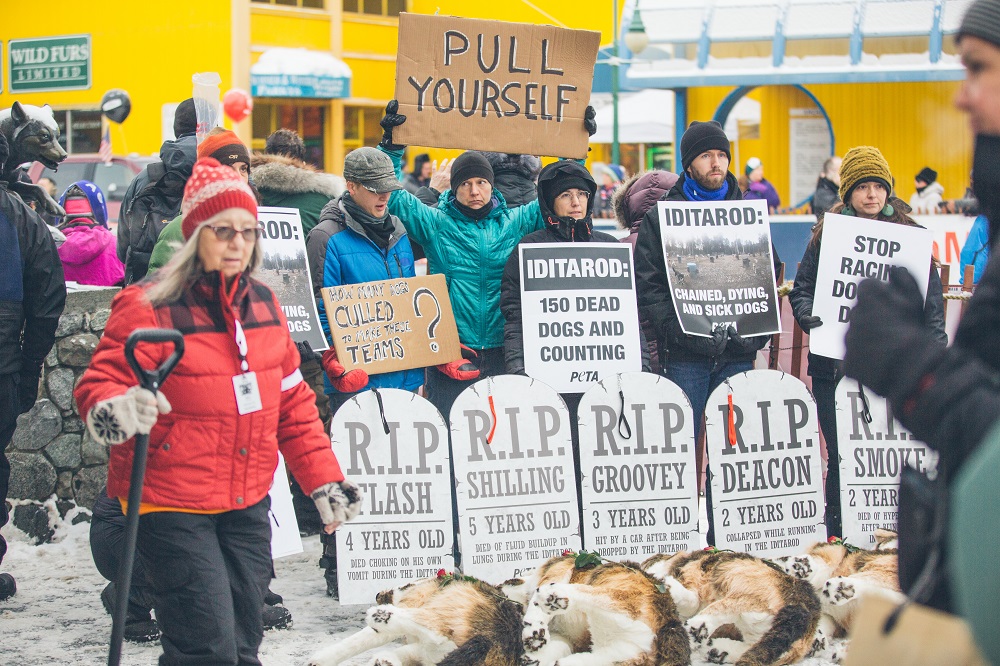2018 Iditarod Wraps Up: Dog Death, Hundreds Exhausted and Injured
March 19, 2018, Update: A necropsy report ordered after the death of a 5-year-old dog named Blonde has been completed. According to a statement, authorities found Blonde’s death consistent with aspiration pneumonia, showing he likely choked to death on his own vomit from being forced to run excessively hard. Katherine Keith— the musher who ran Blonde to his death— had a dog on her team die from a similar reason last year.
A total of 350 dogs were pulled out of the Iditarod race this year— likely because of exhaustion, illness, or injury. PETA is calling for the release of the veterinary records of every dog removed from this year’s race so that a true picture of the enormous suffering that these animals endure can emerge.
Thankfully, the 2018 race is over, and we’ll continue to protest this deadly spectacle until all animals are no longer forced to run in the Iditarod.
Learn more about the Iditarod on The PETA Podcast:
Listen to more episodes on iTunes and Spotify! Subscribe for new episodes.
March 16, 2018, Update: Dr. Christine Capaldo, a veterinary adviser to PETA, offered her expert opinion on the “pneumonia-related” death of a dog named Blonde during the 2018 Iditarod:
Pneumonia in young dogs occurs most often because of infectious causes (viral, bacterial, or parasitic) or because of the aspiration of foreign material (food particles, vomit, dust, or irritating substances).
The dogs used in the Iditarod are being overexerted, causing extreme fatigue and exhaustion, in addition to suppressing their immune systems. This is likely causing them to be far more susceptible to viral or bacterial pneumonia. Dogs who are stressed are also likely to develop other conditions, such as stress colitis, which can cause bloody diarrhea, dehydration, and vomiting. Vomit that is inhaled is likely to cause inflammation and infection in the lungs, especially in a dog who is being forced to run many miles a day without adequate rest or shelter.
Dogs who develop respiratory illness require prompt treatment, rest, and proper nutrition. Any delay in treatment, chronic stress on the body, or chronic exposure to cold temperatures can cause rapid deterioration, sepsis, respiratory failure, or even death.
March 15, 2018, Update: According to reports, Blonde—a dog owned by musher Katherine Keith, whose dog Flash died in last year’s race—has died during the 2018 Iditarod.
Blonde was one of more than 330 dogs pulled out of the Iditarod during the race, likely because of exhaustion, illness, or injury, and his death from a lung problem pinpoints precisely why this race must end. PETA is calling for the release of the veterinary records of every dog removed from this year’s race so that a true picture of the enormous suffering that these animals endure can emerge. Mushers are using and abusing dogs and then leaving broken ones behind in their pursuit of prize money.
March 14, 2018, Update: PETA protesters were on the scene to greet race “winner” and champion of cruelty Joar Leifseth Ulsom and the poor ravaged dogs he forced to run more than 100 miles a day through biting winds, blinding snowstorms, and subzero temperatures.
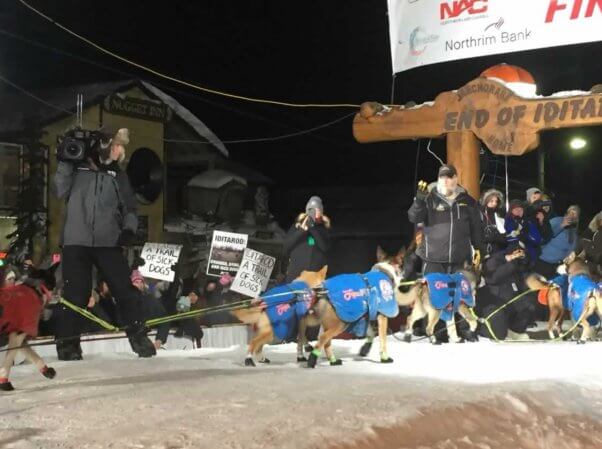
At least 21 dogs from the three leading teams were pulled out of this year’s race, likely because they were too sick or injured to go on, leaving the remaining dogs to do even more work—and PETA is calling for the veterinary records of every single one of them to be released.
This cruel, greedy pastime has caused at least 150 dogs to die in horrific ways since it began, including from aspirating on their own vomit to suffering from heart attacks or bleeding stomach ulcers—and this number doesn’t even include the dogs who died immediately after the race or while chained to barrels during the off-season.
As damning reports of dog doping and rampant behind-the-scenes neglect and killings expose the Iditarod for the horror show that it is, PETA contends that 2018 must be the last time that dogs run more than 1,000 miles, with just 40 hours of mandated rest, all to line a lowlife’s pockets with prize money.
March 13, 2018, Update: Mitch Seavey, a top contender in this year’s race, has passed through the Unalakleet checkpoint—mile 718 of nearly 1,000. But the good news begins and ends there. The dogs forced to pull him through the snow are suffering. Although he began the race with 15 dogs, he’s now down to nine. Those who remain appear exhausted—the leading pup was reportedly “meandering” to the checkpoint. Others are sick, some have aches and pains, and one hasn’t been eating well, according to Alaska Public Media.
March 12, 2018, Update: It’s been barely a week since the deadly Iditarod race kicked off, but the mushers—or human sled drivers—are already feeling the effects. According to the Anchorage Daily News, the sleep-deprived participants are so tired that they’re hallucinating.
Canadian musher Bradley Farquhar believed that two trees he spotted were actually big, floating dog heads, while Iowa-born musher Emily Maxwell hallucinated that there were mounds of garbage and small animals, including cats, along the trail. Both rookie mushers admitted that it’s difficult for them to stay focused and alert—Farquhar even confessed that he nodded off several times while upright on his sled. But these disturbing admissions are hardly new. Musher Linwood Fiedler fell asleep and fell off his sled during last year’s race. According to reports, Rumble and Josie—two dogs forced to pull Fiedler and his sled—left their sleeping musher behind, running to the next checkpoint.
But while these mushers complain of sleep deprivation, it’s the dogs who have to keep on running—up to 100 miles a day, with only 40 hours of rest mandated over the race’s entire span of up to about 350 hours. If mushers are passing out, even falling off sleds, when all that they have to do is stand or sit there, imagine how debilitating this event must be for the dogs who are forced to run, no matter how exhausted they are. If mushers want to prove that they’re endurance athletes, they should run the 1,000 miles themselves and leave the dogs out of it.
March 9, 2018, Update: The dogs who are used and abused by their human sled drivers aren’t the only animals affected by the cruel Iditarod race. According to the Anchorage Daily News, 63-year-old musher Marcelle Fressineau and the 14 dogs forced to pull her came face to face with two bison and their baby on Tuesday. After the dogs seemed to panic, Fressineau went after the bison with an ax.
This is not the first run-in between bison and Iditarod participants. In 2002, a bison charged dogsled driver Aliy Zirkle. Everyone made it out alive, but that didn’t stop Zirkle from threatening, “It’s a good thing I didn’t have a gun, because I’d still be there cleaning her [the bison].” In 2016, a bison became agitated when driver DeeDee Jonrowe and the dogs tugging her pulled up next to him. The bison, who was pooping, charged the musher and the dogs. Jonrowe said that she believed the bison was pulling a “macho man bluff.”
March 8, 2018 Update: KTVA 11 News has reported on an unabridged version of the 2017 toxicology report that sparked the Dallas Seavey doping scandal. In the uncensored document, it’s noted that a second team of dogs tested positive for a banned substance called lidocaine.
Who operates this team of dogs? None other than Iditarod star Wade Marrs. Just before Wednesday’s official Iditarod restart in Nome, AK, Marrs was allegedly approached by Dr. Morrie Craig— who leads the race’s drug testing program— and was told to stop his “workings” with the Iditarod Official Finishers Club (IOFC) and the notorious Dallas Seavey. If Marrs failed to do so, Dr. Craig allegedly threatened to release the scandalous doping information to the public.
March 5, 2018 Update: Zoya DeNure has dropped out of the Iditarod race. Among the dogs on Denure’s team included Honey, who Iditarod handler turned whistleblower Ashley Keith filmed with an apparently bloody and sore paw before the race even began. We are glad that Honey and her fellow dogs won’t suffer on the deadly trail, but our work isn’t done until all dogs are free from this race’s torment.
March 4, 2018 Update: It wasn’t long before activists in Alaska noticed a dog suffering for the Iditarod. Whistleblower Ashley Keith filmed Honey— a dog who will be forced to run as a part of musher Zoya DeNure’s team— with a bloody paw, and apparently sore paw. DeNure received media attention last year after accusing mushers like Dallas Seavey for killing “hundreds on top of hundreds or more dogs” because they were too weak or too slow for racing.
The race hadn’t even started and a dog, named Hudson, escaped his kennel and bolted out of a housing trailer. Hudson was later found, but other dogs in the past haven’t been as lucky. Two dogs in the last four years have been killed after fleeing before the Iditarod began.
Originally published March 4, 2018.
The Iditarod Race kicked off this weekend in Anchorage, AK, sparking protests from PETA, whistleblowers, and other activists who want to save dogs from dropping dead in the archaic event.
During the opening Iditarod Ceremonial Start, a group of PETA supporters gathered around five headstones—engraved with the name, age, and cause of death of each dog who died during the 2017 Iditarod. PETA will also lead a second protest outside the race’s Willow restart and another at the race’s end in Nome.
Fern Levitt— director of the sagacious investigative documentary Sled Dogs— joined the protest and screened the film right after the ceremonial start at the Wilda Marston Theatre.
More than 150 dogs have died in the Iditarod since it began, and those are just the reported deaths—this doesn’t include dogs who died immediately after the race, during training, or while chained to plastic barrels outside during the off-season. Recently, a whistleblower released disturbing photographs and video footage of reportedly dying puppies and sick, injured dogs at a kennel owned by “Iditarod royalty” Dallas Seavey, the four-time race champion who was also at the center of a dog-doping scandal.
What You Can Do
Dogs deserve far better than a lifetime of isolation, cruelty, suffering, and death for the Iditarod.
After hearing from PETA supporters, many companies have dropped their Iditarod sponsorships. But some others, including Millennium Hotels and Resorts continue to fund this deadly spectacle. Stand with PETA and demand that they stop sponsoring this abusive race.

